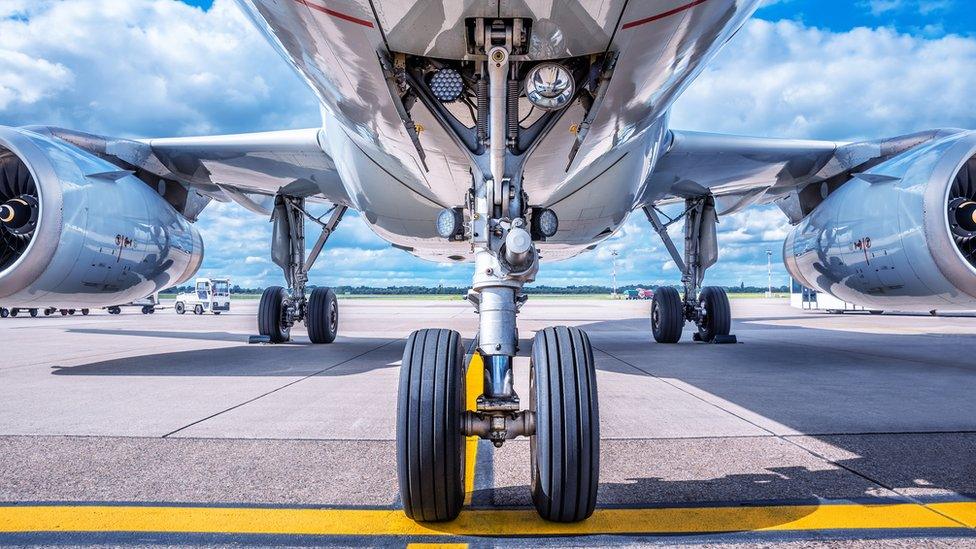Plane stowaways: Do any survive?
- Published

A suspected stowaway is believed to have fallen to his death from a Kenya Airways flight from Nairobi to Heathrow, landing in a garden in south London.
But how often does something like this happen and what would conditions have been like during the journey?
How often do stowaways hide on planes?
Although unusual, this is not the first time that someone has hidden on board an aircraft bound for the UK.

A body was found in a garden in Offerton Road in Clapham
Between January 2004 and March 2015, six stowaways were found on aircraft at UK airports, according to the most recent figures from the Civil Aviation Authority (CAA), external. Another stowaway was found on board a UK airline at an overseas airport.
Figures from the US Federal Aviation Administration suggested that 96 people hid under planes during flights around the world between 1947 and 2012, with incidents occurring on 85 flights.
Aviation expert Irene King told the BBC that many stowaways don't make it to their destinations, making it difficult to gauge the number of incidences.
How many stowaways are killed?
There have been several cases of stowaways being found dead in the UK.
In 2001, the body of Mohammed Ayaz, 21, from Pakistan, was found in the car park of a branch of Homebase in Richmond, near Heathrow Airport. Four years earlier, another stowaway fell from a plane on to a gasworks near the store
In 2007 the body of a young man was found in the landing gear of a British Airways plane in Los Angeles, external.
In August 2012, a man's body was found in the undercarriage bay of a plane at Heathrow after a flight from Cape Town. The next month, Jose Matada, 26, from Mozambique, was found in a street in Mortlake, West London. He died of multiple injuries after falling from a plane travelling from Angola.
In September 2012, a man in his twenties was found dead in Portman Avenue, a suburban street in west London.
In June 2015, one man was found dead on an office rooftop in Richmond. Another was found in a critical condition at Heathrow. It is thought that they had clung to a British Airways flight from Johannesburg.
Survivors tend to have travelled fairly short distances and to have been fairly young.
In June 2010, a 20-year-old Romanian who survived was found inside a wheel bay after a flight from Vienna landed at Heathrow Airport. In that case, the jet had kept below 25,000ft because of bad weather.
Of the cases identified by the US Federal Aviation Administration, 23 people - about one in four - had survived the journey.

Other extreme wheel well survival stories
1969 - Armando Socarras Ramirez, 22, managed to withstand the effects of a flight from Havana, Cuba, to Madrid, suffering frostbite but no major damage
1996 - Pardeep Saini, 23, stayed alive during a 10-hour flight from Delhi to London, but his brother Vijay died falling out of the aircraft as it approached Heathrow
2000 - Fidel Maruhi survived the 4,000-mile journey on a Boeing 747 from Tahiti to Los Angeles
2002 - Victor Alvarez Molina, 22, got through the four-hour flight on a DC-10 from Cuba to Montreal, Canada
2014 - Yahya Abdi, 15, stowed away in a Boeing 767 from San Jose, California, to Maui, Hawaii

What happens during the flight?
There are serious risks associated with the extreme conditions people face if they try to travel in the undercarriage of a plane.
These include being crushed when landing gear retracts, frostbite, hearing loss, tinnitus and acidosis - the build-up of acid in body fluids which can cause coma or death.
During the flight, temperatures can drop to as low as -63C (-81F), bringing on hypothermia.
At 18,000ft (5,490m), hypoxia sets in, where the whole or part of the body is deprived of an adequate oxygen supply. It causes weakness, tremors, light-headedness and eyesight problems.
Video shows stowaway Yahya Abdi emerging from jet plane wheel
Above a typical long-haul cruising altitude of 33,000ft (10,065m) - or higher - lungs require artificial pressure to function normally.
When a plane reaches 22,000ft (6,710m), a stowaway will be struggling to keep conscious as blood oxygen level drops.
Then compartment doors re-open a few thousand feet above ground for landing, which can cause stowaways to fall to their deaths.
How do they get on board?
Airside control areas in some parts of the world do not have the same level of security as they do in the UK.
Stowaways can get on board if the proper checks are not carried out.
In the case of the man who died in August 2012, after stowing away on a flight from Cape Town to London, the warning came too late.
The crew onboard were told during their journey that a security fence had been breached in Cape Town and that someone had been seen climbing into the undercarriage.
Who are the stowaways?
Most tend to be men who are attempting to make their way to Europe or North America, from developing countries.
It has been suggested that some stowaways are trying to escape persecution in their home country, or are fleeing conflict situations.
Others may be hoping to find work and the chance of a brighter economic future.
Dr Lisa Doyle of the Refugee Council, said: "We urge the government to provide more safe and regular travel routes for refugees as a vital way of preventing these tragic events from happening."
- Published19 June 2015
